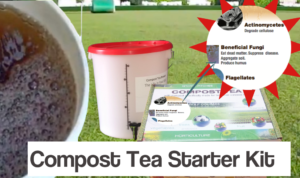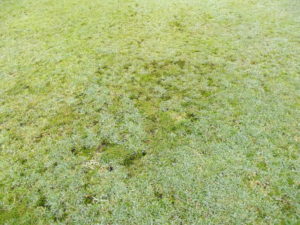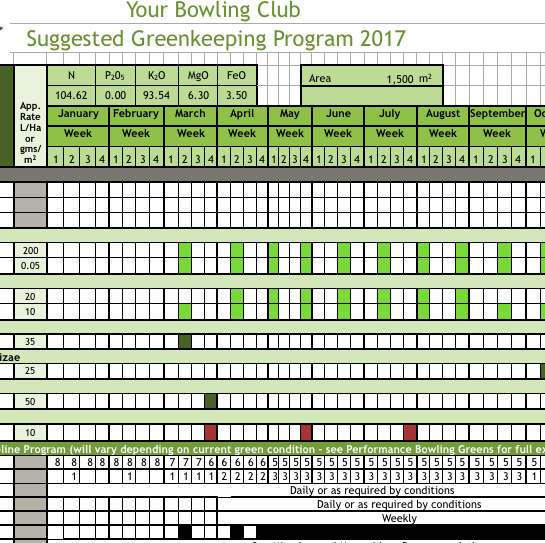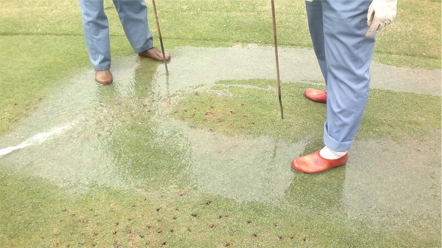Here are the recommended Greenkeeping tasks for May maintenance work for the Performance Greens Program.
With soil temperatures rising, this should be the month that sees the maximum growth on greens around the country, but with a few exceptions many of you will be feeling the pressure from the unusually dry weather we’ve had for the past few weeks.
This has certainly stunted growth and left a lot of greens well behind the growth curve we would normally expect at this time of year.
This means that Localised Dry Patch has shown its ugly face on a few greens already, something that needs to be tackled head on now, as it can be quite devastating to green performance if allowed to run on unchecked. If this is something your green is suffering from, there’s more detailed information about its causes and cures here.
Also, as if by magic given that I write them a month ahead of time, my column in Bowls International this month is all about dealing with Localised Dry Patch.
Mowing
Mowing frequency should be up to summer level of 3 cuts or more per week by now, but again, the dry weather might well be holding you back on this.
Mowing height in normal circumstances would be coming down to summer 4.5-5mm by now, but if your area is dry like many others it might be wise to hold off in dropping the blades until there has been significant rain or you’ve caught up with irrigation.
Another trick that might help a little with very dry turf is to leave the box off the mower and to let the clippings fly. This helps to retain a bit more moisture as the clippings provide a mulching effect on the soil.
Micro Nutrients
Micro nutrients or trace elements are particularly important when grass is under stress so I recommend continued use of Super Concentrated Seaweed Liquid with its plethora of trace elements and natural plant inoculants. Trace elements like Copper and Zinc are known to help grass plants fend off attacks from fusarium and other fungal pathogens and its bio-stimulant properties helps to keep the microbe population growing and active. You can quite happily apply this all year round as a bio-stimulant.
Scarifying/Verti-cutting
On recovering greens (still thatchy and in the Circle of Decline) I would normally recommend continued verti-cutting through the summer, but again very dry conditions should be the exception to this as it does have a drying out effect on the turf.
It is important that there is sufficient growth to support the recovery, so hold off on this if you aren’t seeing that yet either.
When conditions are suitable a light verti-cut twice a month can really help with keeping thatch build up under control.
For this operation the blades should barely be touching the soil as the main purpose is to slice through stolons (encouraging vegetative reproduction) and teasing up lateral growth.
Compost Tea
 Whether your green is drought stressed or not, but more especially if it is, this is the optimum time to get started on a Compost Tea program.
Whether your green is drought stressed or not, but more especially if it is, this is the optimum time to get started on a Compost Tea program.
On greens that have been managed in the conventional way for any length of time i.e. using pesticides and inorganic fertilisers, it’s likely that the soil microbe population will be significantly depleted. There might also be gaps in the eco-system, essentially “missing microbes”. Compost Tea provides a fresh population of the full range of microbes to bolster existing populations and even re-establish missing ones. Through repeated applications of your Compost Tea these new microbes will establish and replicate. The benefits of this full and abundant population of soil microbes will be manifold as their specific enzymes and toxins act in the soil encourage plant health for the very species you want to promote. Even in relatively healthy greens, where thatch is under control and a more natural greenkeeping program is already used, Compost Tea provides a wonderful probiotic boost, maintaining microbe diversity and helping to compensate for microbes lost through predation and prolonged reliance on pesticides and high salt index fertilisers.
Tank mix the compost tea with Liquid Seaweed for an additional bio-stimulant boost to keep your turf healthy and thriving.
More on Compost Tea here.
Moss
 Greenkeeping tasks for May include dealing with the Moss that is still lingering on many greens and strangely enough, the dry conditions will actually help it stay around in many cases as the grass isn’t yet competing with it or growing vigorously enough to crowd it out.
Greenkeeping tasks for May include dealing with the Moss that is still lingering on many greens and strangely enough, the dry conditions will actually help it stay around in many cases as the grass isn’t yet competing with it or growing vigorously enough to crowd it out.
Moss has been a continuing problem for many readers. Moss takes hold in any space that is left in the sward, and is particularly troublesome when there is little grass growth to speak of.
Moss will also continue to be a problem on greens that are in the throes of the Circle of Decline, so until your green has fully transitioned into a healthy, perennial dominated one, this will continue to be a problem, albeit decreasingly so.
The best way to deal with moss now is to concentrate on getting grass growth going well and this might need a more regimented approach to irrigation management. In the past at many clubs the irrigation system has been both friend and foe and although it seems a fairly straightforward idea, irrigation is widely misunderstood.
In Performance Bowling Greens I’ve laid out a whole section on managing irrigation effectively.
Nutrition and Fertiliser
Greenkeeping tasks for May include managing nutrient supply well, as this is vital to creating a performance green surface that is consistent throughout the season. Peaks and troughs of growth are the enemy of green speed and smoothness.
This is why it’s best to use Bio Liquids as the regular and light applications help to provide the required Nitrogen as it’s needed instead of encouraging flushes of growth all at once.
Bio Liquids also provide a boost of carbohydrate to the soil microbial population to help keep them growing and multiplying. Over time, this alone can reduce the need for fertiliser applications, as when your soil is firing on all cylinders the microbial activity within it can easily produce more than half of the green’s annual Nitrogen requirement on its own.
Aeration
Sarrel rolling continues to be the method of choice even when the soil is dry. It is also a very useful operation for letting irrigation into a crusted surface. It keeps air movement going just sub-surface where the microbes roam too. You can do this as regularly as you want and it is a really useful pre-compost tea application job.
Looking forward to Performance Greens
With the new season under way, many clubs are coming round to the fact that they’ve been chasing symptoms for years and not tackling the underlying causes of poor green performance. Why not make this the year you finally commit fully to achieving a Performance Bowling Green? The ebook that’s caused all the fuss is well under the price of a bag of fertiliser!…more here.

Soil Analysis with done for you greenkeeping schedule.
In addition to absorbing the message in Performance Bowling Greens, why not let me do a soil analysis for you. I’ll send you a kit to take the samples and also ask you some questions about the physical condition of your green, photos etc. More details of this unique service here.
Questions Please
Of course as always, if you have any questions comments or problems, please feel free to drop me a line.
Performance Greens Materials
All of the materials you need are available in the shop now. Have a browse and feel free to come back to me with any questions you have about applying the Performance Greens Program.



